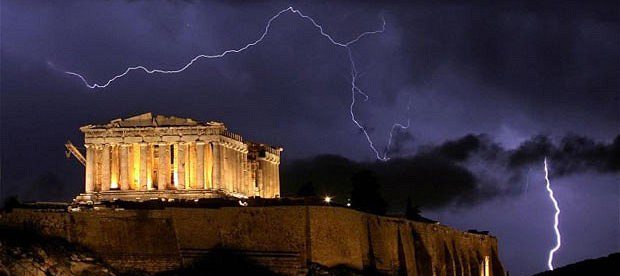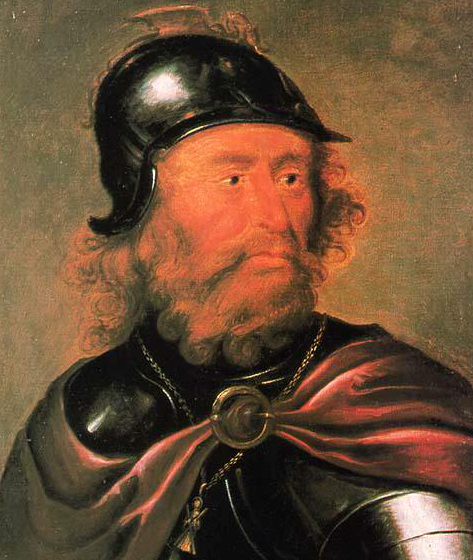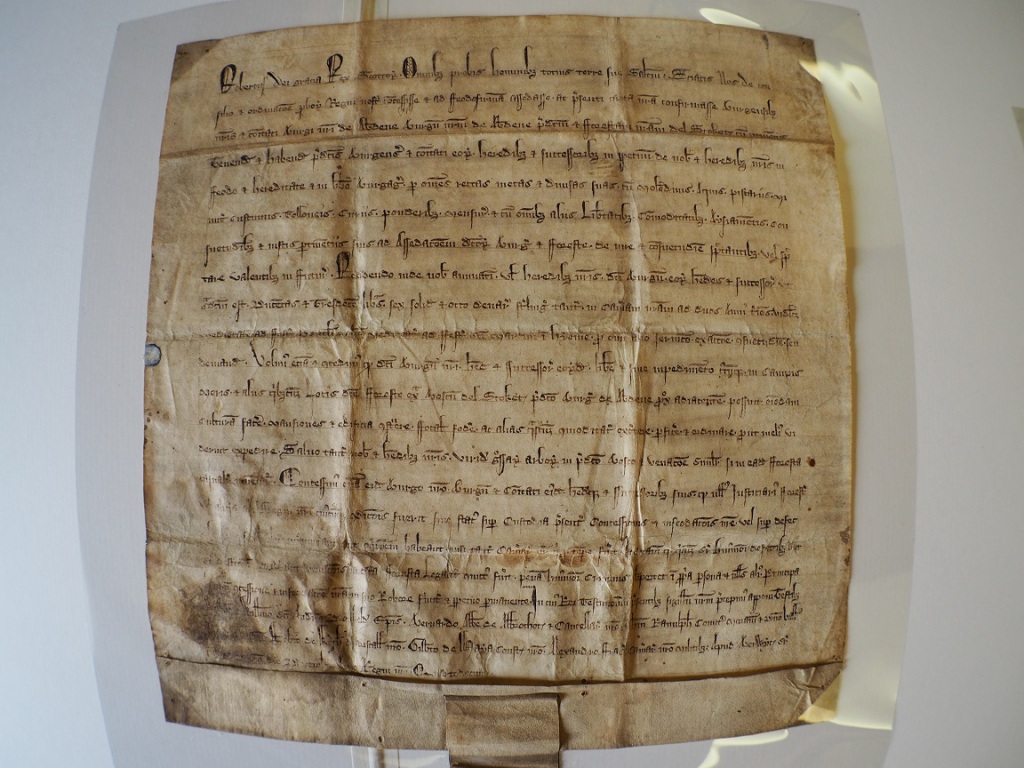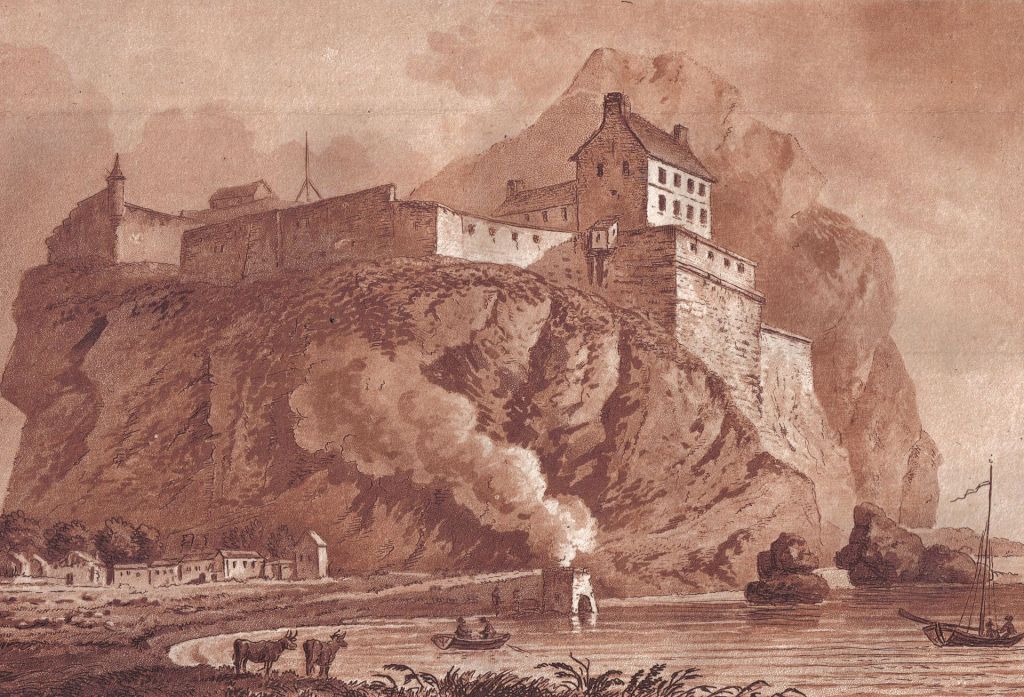Robert the Bruce
Bruce’s 1st wife Isabel of Mar died giving birth to a daughter Marjorie. Marjorie married a Stuart & gave Birth to the 1st of the Stuart Line of Kings. Bruce was also very close to Isabel’s brother & her sister-in-law.
The Mar‘s had a Residential House in Aberdeen then situated in the Gallowgate and known as Mar’s Castle. Some say that Bruce had more Celtic leanings than Norman, perhaps because he had been Fostered to a Celtic Family on his Father’s Estate when young.
(A Tale of he & his “Foster Brother” being Attacked by 3-Assassins when he had taken to the Heather, gave rise to this. Bruce’s “Foster Brother” was Murdered & Bruce Killed all 3 of the Assassins. Celtic Chiefs often Fostered their sons to respected men of the Clan, to teach them qualities they needed & remove delusions of Grandeur.)
The Braemar area figured large for Bruce. Aberdeen’s support of him during the War of Independence was rewarded with the Legacy for the Common Good. By contrast, Buchan was totally destroyed of all Domestic Animal & Human life, for the Earl of Buchan siding with the English.
Other than the Financial Benefits of Victoria beginning the Tourist Trade in Deeside, it is doubted if any other Scottish King was as generous to Aberdeen as Bruce was. He figured large in Aberdeen’s History.
Charter by King Robert the Bruce to the Burgesses of Aberdeen, 10th December 1319 – Translation
Robert, by the Grace of God King of Scots, to all good men of his whole Land, Greeting. Know ye that, with the Advice & Approval of the Good Men of our Kingdom, we have Granted & Set to Feufarm & by our Present Charter confirmed to our Burgesses & Community of our Burgh of Aberdeen, our foresaid Burgh of Aberdeen & our Forest of the Stocket with the Pertinents; to be Held & had by the foresaid Burgesses & Community, their Heirs & Successors, for ever, of us & our Heirs in Fee & Heritage & in Free Burgage, by all their Right Meiths & Marches, with Mills, Waters, Fishings, Petty Customs, Tolls, Courts Weights, Measures & with all other Privileges, Conveniences, Easements, Usages & their just Pertinents by Law & Usage belonging, or which shall in future belong, to the Sett of the said Burgh & Forest; paying yearly therefor the said Burgesses, their Heirs & Successors, to us or to our Heirs, as aforesaid, £213-6s-8d Sterling only, into our Treasury at 2-Terms yearly, half at the Feast of Pentecost (50-Days after EasterSunday) & the other half at the Feast of Saint Martin (then 11th Nov) in Winter, in place of all other Service, Exaction, Usage or Demand. It is also our Will and we Grant that our said Burgesses, the Heirs & Successors thereof, Freely & without Hindrance from anyone, in the Fields, Moors & other portions whatsoever of the said Forest outwith the Wood of the Stocket, hard by the foresaid Burgh of Aberdeen, may perform every kind of Tillage, Erect Dwelling-Houses & other Buildings, Dig Fuel & Exercise, Carry Out & Regulate other Conveniences whatsoever, as they shall see fit to arrange: reserving for Ourselves & our Heirs only the Green-growth of the Great Trees in the foresaid Wood & Game likewise, should any such chance to be found in the same Forest. We have likewise Granted to the same our Burgh, the Burgesses & Community thereof, their Heirs & Successors, that no Justiciar of the Forest or any other Person of our Kingdom, of whatsoever Condition or Rank he be, shall in any way Interfere with or take Cognisance of the Administration of the Present Grant & our Infeftment, or of Infringements thereof, save only our Chamberlain for the time being; but so that whosoever shall be Lawfully Convicted of such Infringements, or of destroying the Green Wood, or the Game in the said Forest, shall undergo the Punishment of such Crime in his own Person & no other: the Chief Grant, however & our Infeftment remaining in Full Force Strictly & Forever. In Witness whereof we have Ordered our Seal to be Appended to these Presents.
Witnesses:- William, Bishop of Saint Andrews, & William, Bishop of Dunkeld; Bernard, Abbot of Arbroath, & our Chancellor; Thomas Ranulph, Earl of Moray, & Lord of Annandale & Man; Robert of Keith, our Marischal; Gilbert of Hay, our Constable; Alexander Fraser, our Chamberlain, – Knights. At Berwick-on-Tweed, the 10th day of December, in the 14th Year of our Reign.
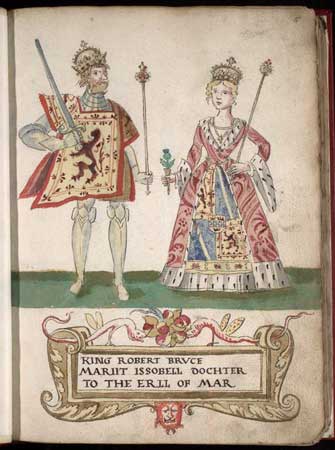
One of his Descendant Kings wondered what Bruce & Wallace looked like. His Courtiers found a woman, remarkably still alive, who had seen both Robert the Bruce & William Wallace as a young girl. A visit to her was hastily made before she expired of old Age.
Asked about the appearance of the 2, she said something along the Lines of “Wallace was a magnificent man & Handsome, but The Bruce was Beautiful.” Those are the only recorded remarks ever made about their appearance while they were Alive & no likenesses were ever made in their lifetimes. Bruce’s Skeleton showed he had such powerful Shoulder & Back Muscles that Doctors from Edinburgh spotted the Muscles had bent the Bones.
Bruce had obviously been Trained from a young age with Weapons, no doubt the 40lb Knight’s Sword in particular. This Training had developed his Upper Body Muscles to an unusual Degree. It has been interpreted from his Celtic Blood Lines, that any Norman Physical Inheritance was well Watered down, & that he had more than likely been quite dark haired, even sallow skinned. So, in appearance, his face is more likely to be closer to that of Bruce’s Statue at Bannockburn. His Upper Body Physique would have been closer to a Body Builder. A Knight’s Sword is nothing like the one sported by Statues. A Battle Axe would have been more appropriate, recalling his Duel with his Distant Relative, Henry de Bohun at Bannockburn who was Astride an Armoured Shire Horse, whilst surprised Bruce was on a Pony Touring his Outer Defences. The Shire Horses of English Knights taken at Bannockburn, nor the Ponies of Scotland befit such Portrayals.
When Wallace was taken to England for his so-called Trial, his Ankles were tied together under the Horse: he obviously was very Long Legged & Astride a Pony.
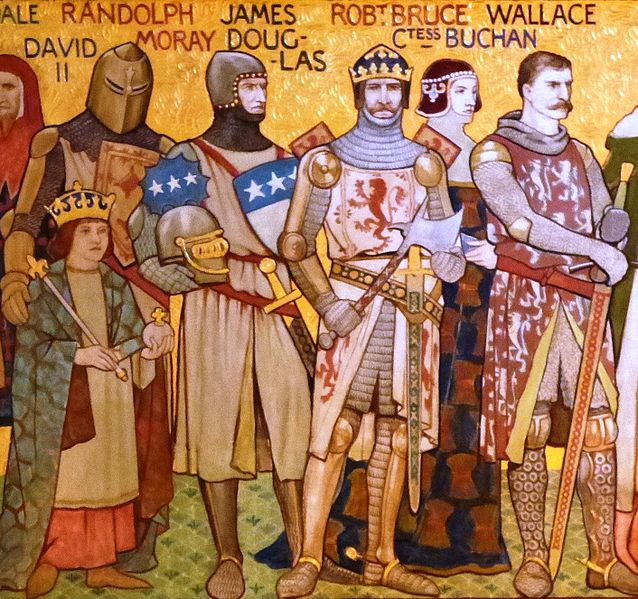
The Bruce in Retirement
His Retirement Home at Cardross was long ago flattened by Victorian Civil Engineering Works in the Area, even to History forgetting where it once Stood, and his exact Burial Spot at Dunfermline Abbey was also forgotten until Victorian Times, when renovations uncovered his Skeleton, shows a strange attitude by Scots towards the Hero King. The Myths are revered, but his Real Memory has been forgotten. Could that have been deliberately Fostered? Post Union Madness?
” ‘Sirs,’ he said, ‘my day is far gone and there remains but one thing, to meet Death without Fear, as every Man must do. I thank God he has given me the space to repent in this Life, for through me & my Wars, there has been a great Spilling of Blood & many an Innocent Man has been Slain. Therefore I take this Sickness & this Pain as a Penance for my Sins.’ ”
Bruce & Leprosy
The 1st mention of the possibility that Robert I might have suffered from Leprosy appears in the Chronicon de Lanercost, a General History of England & Scotland from 1210 to 1346 which has been attributed to an unknown Franciscan Friar at Carlisle. This States that Bruce Deputed the Command of the Army during the Weardale Campaign in 1327 because he had developed Leprosy – “Dominus autem Robertus de Brus, quia factus fuerat leprosus, ilia vice cum eis Angliam non intravit”. However, in spite of this Contemporary Assertion, there has always been some doubt as to whether Bruce, who died in 1329, did suffer from Leprosy. It has suggested that his condition could have resulted from “sporadic Syphilis“, which in the Middle Ages was commonly confused with Leprosy.
In 1817, the Magistrates of the Burgh of Dunfermline resolved to rebuild a new Church on the Site of the Nave of the Ruined Ancient Cathedral Church of Dunfermline. During the clearance of the Site, Workmen accidentally came across what appeared to be a Royal Tomb located at the very centre of the Ancient Cathedral in Front of where the High Altar had formerly stood. This was protected by 2-Large Stones, a Headstone & a much Larger Stone (6-ft in length) into which 6-Iron Rings had been Fixed by Lead. When these Stones were removed, they found the complete Skeletal remains of an Individual entirely enclosed in 2-Layers of Lead, with what remained of an Embroidered Linen Cloth Shroud over it, the Fine Linen material being Interwoven with Threads of Gold. Over the Head of the Individual, the Lead was formed into the shape of a Crude Crown. The Find was reported to their Lordships, who directed the Sheriff to Secure the Tomb. The Skeleton, formally Exhumed in 1819, was Attributed to Robert I on the basis of the Sawn Sternum; a procedure carried out after death to Remove his Heart in accordance to Robert’s Wish to have it carried by Sir James Douglas during a Crusade against Saracens. Douglas Obeyed his King’s Wishes but died en-Route in Spain. The Heart was returned to Scotland & was Buried at Melrose Abbey, the most important Cistercian House in Scotland. The Exhumed Skeleton was Studied by a number of Medical Specialists including Dr Alexander Monro, Tertius, Professor of Anatomy at Edinburgh University. An accurate Plaster-of-Paris Cast was made of the Skull & Mandible by W Scoular.
All available evidence suggests that the Original Copy of the Cast is now Located in the Anatomy Museum of the University of Edinburgh. Copies of this Cast have been used to produce the Portrait Head of Robert I that was displayed in the Royal Scottish Academy in 1958; & more recently the Reconstruction of the Facial Features by George Buchanan & Computer-aided reconstruction prepared by Professor Vanesis of the Forensic Medicine Department of the University of Glasgow. The Cast confirms that Robert I suffered the loss of his Upper Incisors & associated Alveolar Maxillary Bone. These features have been interpreted by V Moller-Christiansen & R G Inkster, Authorities on the Osteological appearance of Leprosy, as typical of Facies Leprosa & not those of Calvaria Syphilitica (Syphylitic Osteitis). According to the latter Authors, the Cast displays “antemortem Loss of the Central & Right Lateral Incisors & possibly the Left Lateral Incisor“. The Authors continue: “There are no signs of Loss of Teeth caused by Trauma in vivo. But the most important component of the Facies Leprosa, the inflammatory changes in the Hard Palate, cannot be verified in this case because the Plaster Cast does not show the Hard Palate & so does not allow Investigation. The Plaster Cast of Robert the Bruce shows clear Signs of Facies Leprosa, but to be 100% sure of the Diagnosis of Leprosy, we would have to unearth his Skeleton once more & make a proper examination.”
Malcolm, Earl of Lennox, Resigned into the hands of the King, Robert I, a Plough of Land of Cardross (modern day Renton), getting in Compensation the half of the Lands of Lekkie in Stirlingshire. The King, about 1322, gave over the Lands of Hoyden, within the Barony of Cardross, to Adam son of Alan & he had a Specific object in view in acquiring Land in the Parish. For upon a Bank overhanging the River Leven, near its Junction with the Clyde, the Hero of Bannockburn Built a Manor House & surrounded it with a Park, which was called the King’s Park of Cardross. At the 1st Milestone out of Dunbarton, along the Cardross Road there is a Wooded Knoll, which bears the name of Castlehill although there are no traces of any Ruined Buildings to be seen.
Having divested himself of the cares & vexations of Government, the Bruce found relief in the Chase, and indulged in Hunting Excursions & made Short Voyages along the neighbouring Waters of the Gareloch & Loch Long & the Broad Estuary of the Clyde, while he was kept in Security by the neighbouring Castle of Dunbarton. Within the Walls of his Residence, in View of the fine Hills, which throw their dark shadows over the placid Waters of the River Leven at Renton, the Patriot King breathed his Last on 7th June, 1329.
By the Advice of his Physicians he had Retired to Cardross, a beautiful retreat situated upon the Clyde, about 6-miles from Dunbarton, where, amid the intervals from Pain & Sickness, his time appears to have been much occupied in making Experiments in the Construction & Sailing of Vessels, with a view, probably, towards the Establishment of a more effective Naval Force in Scotland. We learn this Fact from the Accounts of his High Chamberlain, which are yet preserved & the same Records acquaint us that in these Kingly Amusements he often enjoyed the Society of Sir Thomas Randolph.
The King’s Expenses at Cardross
The following are a few of the Entries from the “Cardross Kings Park Household Book“, – Items:
Wood for the Scaffolding of the New Chalmer, 3s.; making a door for do., 6d.
To 100 large Boards, 3s. 4d.
To Giles the Huntsman for his allowance for 1-year, 6-weeks, 3-days, 1-Chalder 35-Bolls Meal.
Grant to do by the King’s Command, 26s-8d. To a Net for taking large & small Fish, 40s. To 2-Masts for the Ship, 8s.
To Persons Employed in raising the Masts 3-times, 3s.
To working 80-Tons of Iron for the use of the Ships and the Castle at 4d per Stone, 26s-8d.
To bringing the King’s Great Ship from the Firth into the River near the Castle & carrying the Rigging to the Castle, 3s.
To 12-Men sent from Dunbarton to Tarbet to bring back the King’s Great Ship, 28s.
To 30-Loads of Firing to be used in the Work of the Windows, 22s-6d.
To Conveying Peter the Fool to Target (on Loch Fyne), 1s-6d.
The House for the Falcons cost 2s; a Fishing Net, 40s; Seeds for the Orchard, Is-6d.; Green Olive Oil for Painting the Royal Chamber, 10s; Chalk for the same, 6d; a Chalder of Lime for Whitewashing it, 8s.; and Tin Nails & Glass for the windows, 3s-4d.”
His lighter Pleasures consisted in Hunting & Hawking, when his Health permitted; in Sailing upon the Clyde & Superintending his Mariners & Shipwrights in their Occupations; in Enlarging & Enclosing his Park & making additions to his Palace. As even the most Trivial Circumstances are interesting when they regard so Eminent a Man, it may be mentioned that he kept a Lion, the Expense of whose Maintenance forms an Item in the Chamberlain’s Accounts; & that his active mind, even under the pressure of increasing Disease, seems to have taken an interest in the Labours of the Architects, Painters, Goldsmiths & Interior Artists, who belonged to his Establishment. In compliance with the Manners of the times, he maintained a Fool, for whose comfort he was Solicitous & in whose Society he took Delight.
He Entertained his Clergy & his Barons, who Visited him from time to time, at his Rural Palace, in a style of Noble & Abundant Hospitality. The Minutest parts of his Expenditure appear to have been arranged with the greatest Order & his Lowest Officers & Servants, his Huntsmen, Falconers, Dog-keepers, Gardeners & Park-stewards, provided for in Rude but Regular Abundance. His Gifts to the Officers of his Household, to his Nurse & other old Servants & to the most favourite amongst his Nobles, were frequent & ample; his Charity in the support of many indigent Persons, by small Annual Salaries or Regular Allowances of meat & flour, was extensive & well directed; whilst a pleasing view of his generosity, combined with his Love of Letters, is presented by his presents to `Poor Clerks’ for the purpose of enabling them to carry on their Education “at the Schools.”

Rosslyn Chapel – the death mask of Robert the Bruce.
The St Clair Family are said to have Fought with Bruce & Honoured him within the Chapel with this Carving.
Historical & Descriptive Account of Rosslyn Chapel & Castle, with 8 Engravings ~ 1827
The Scene has been often described when the King, feeling his Last Hour drawing near, charged his old friend & companion in Arms, Sir James Douglas, to take, as soon as he was dead, his Embalmed Heart and Deposit it in the Church of the Holy Sepulchre at Jerusalem. This was done, and Sir James Douglas duly set out with a Body of chosen companions for the Holy Land, with his precious charge enclosed in a Silver Casket, but being Attacked by the Saracens & surrounded by overwhelming numbers, he flung the Casket before him, exclaiming, “Pass onward as Thou was Wont & Douglas will follow Thee or Die.”
Bruce’s Heart
In the aftermath of the Battle a Scot, one William Keith of Galston, who had earlier suffered a broken Arm & had took no part in the current Fight, took to searching the Battlefield with the remaining Scots. They found Douglas’s Body, with 5-Fatal Wounds, surrounded by many Bodies of the Enemy. On retrieving Douglas’s Body the Silver Casket containing Bruce’s Heart was discovered underneath him. A few days later the Castle fell to the Christian Forces. Douglas’s men would not hear of him being Buried on Foreign Soil, so in line with current practices his Body was boiled in a Cauldron until the Flesh fell from the Bones, This was buried in Hallowed Ground at Teba, his Skeleton & Heart were taken back to Scotland & Interred in St Brides Church in Douglas Village. Bruce’s Heart was Conveyed to Melrose Abbey & there Buried. In 1920 the Heart was discovered by Archaeologists & was reburied, but the Location was not marked. In 1996, a Casket was unearthed during Construction Work. Scientific Study by AOC Archaeologists in Edinburgh, demonstrated that it did indeed contain a Human Heart & it was of appropriate age. It was reburied in Melrose Abbey in 1998, pursuant to the Dying Wishes of the King.
George Combe frequently reproduced the Skull of Robert the Bruce, although he failed to explain the Mystery of its existence in Plaster. The Skeletons of Bruce & his Queen were discovered early in the 18thC by a party of Workmen who were making certain Repairs in the Abbey Church of Dunfermline. The Bones of the Hero of Bannockburn were identified from the description of the Interment in Contemporary Records & from the fact that the Ribs on the left side had been roughly Sawn away when the Heart was delivered to Sir James Douglas & sent off on its pious & romantic, but unsuccessful, Pilgrimage to the Holy Land. The Skull of Bruce, in an excellent state of Preservation, was examined carefully by the Phrenological Society of Edinburgh, then in the highest tide of its enthusiasm & prosperity; & with the Consent of the Crown, this Cast of it was made. A gentleman who wrote anonymously to ‘Notes & Queries’, 7th August 1859, some 40-yrs later, said that he remembered distinctly seeing & handling the Skull & the great Sensation its Discovery created. It was reinterred in its Original Resting-Place a ‘tiny or two’ later.
